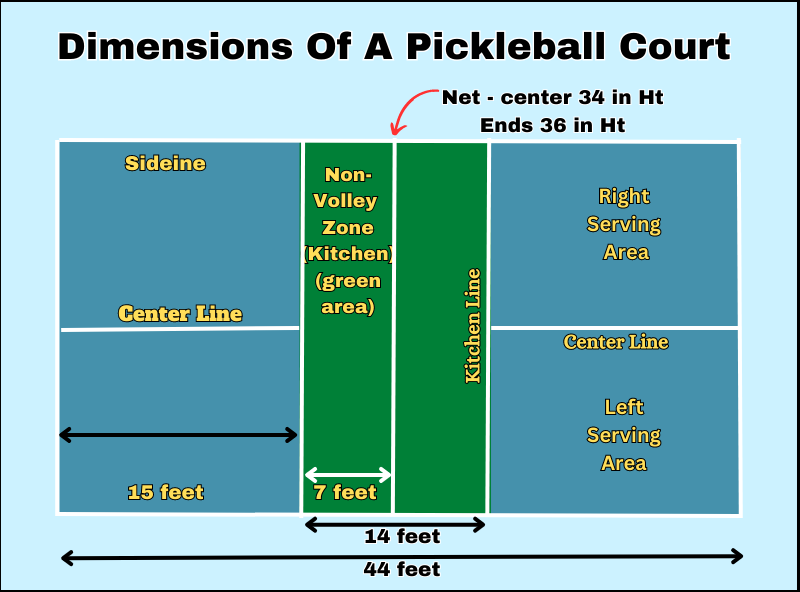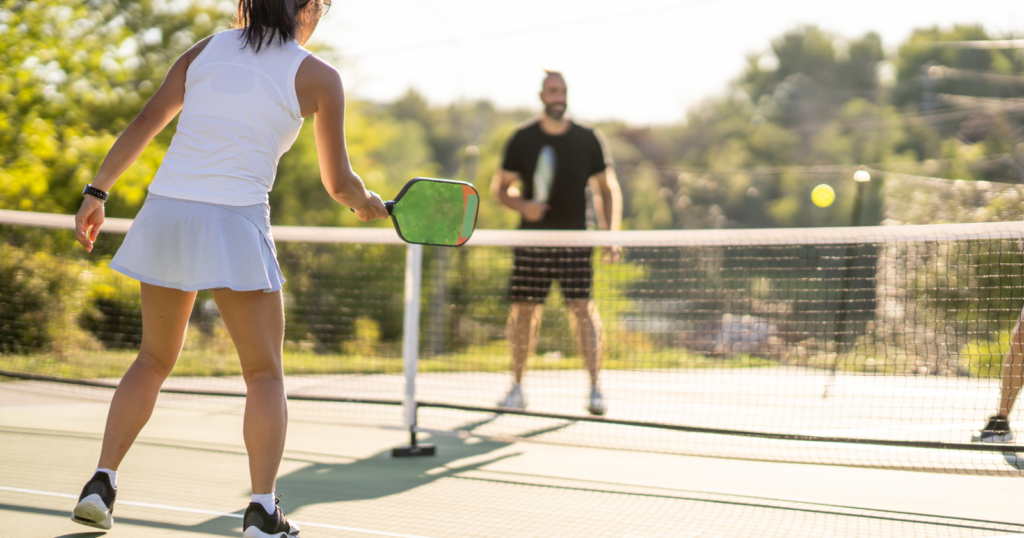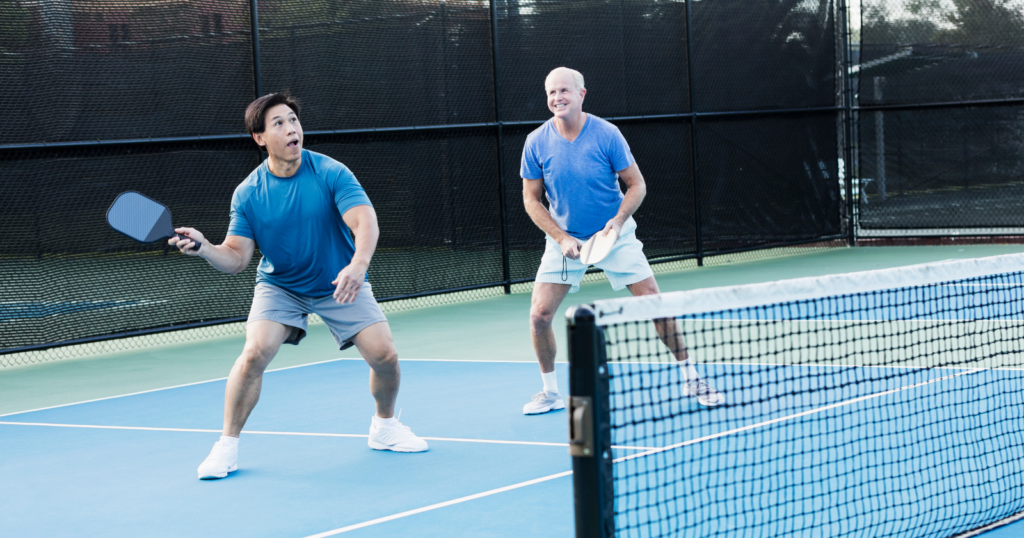You’ve likely landed here after searching for a guide on pickleball kitchen rules. We’ve all been here confused about exactly what you can do in the kitchen. And we are not talking about cooking either, that is, unless you plan to cook up some extra points.
As a teacher in the classroom and on the pickleball court. I belive in the power of knowledge and exercise to improve lives. Understanding the pickleball kitchen rules can make or break your gameplay. Mastering the pickleball kitchen rules can give you a significant edge over your opponents.
My recommendations and strategies are from countless hours of playing pickleball. With practice drills, mental reminders, and the right strategies, you can turn the pickleball kitchen (non-volley) rules to your advantage.
The kitchen has its own set of rules, and most of them relate to not stepping into the kitchen or touching the kitchen line when you hit the ball. Now there is an exception to these rules, and that is when the ball lands in the kitchen, you can step in and hit it back. But let’s go into the Pickleball kitchen rules as we move forward.
Together let’s take a more in-depth look at the pickleball kitchen rules so you can score the winning point.
Definition of the Kitchen
The kitchen in pickleball refers to the non-volley zone. It’s a 7-foot area on both sides of the net. Scrolling just a bit further, you’ll find an image of a pickleball court. The green area is the kitchen. Stepping into this zone during a volley is a no-go, hence the emphasis on understanding its rules.
Importance of the Kitchen in Gameplay
The kitchen plays a pivotal role in pickleball strategy. By controlling the kitchen, you control the game’s pace and can dictate your opponent’s movements.
Key Pickleball Kitchen Rules
Diving deep into the pickleball kitchen rules, there are several key points to grasp. These rules are foundational to the game and can significantly impact your performance on the court.

Non-Volley Rule
One of the primary pickleball kitchen rules is the non-volley rule. Non-Volley rules are the times when you cannot hit the ball while stepping into the kitchen. In simple terms, it is:
- You can’t hit the ball before it bounces if you’re standing in the kitchen.
- Stepping into the kitchen immediately after a volley is also a fault.
- You must start all volleys outside the non-volley zone.
- Players using wheelchairs can have their front wheels touch the non-volley zone while volleying.
What Constitutes a Fault During a Volley
A fault is basically when you break a rule and give the serve to your component. You can only make a point when your team is serving, so you want to keep that ball and avoid faults. It’s a fault if while volleying:
- The player or anything connected to the player touches the non-volley zone.
- The player’s paddle touches the non-volley zone either before or after hitting the ball.
- The player’s momentum makes them touch anything in the non-volley zone, including their partner.
For players in wheelchairs, only the front wheels can touch the non-volley zone during a volley.
The Act of Volleying Explained
We talk so much about volleying, but exactly what does it mean to volley? These two phrases sum it up well.
- The act of volleying includes the swing, follow-through, and any momentum from the action.
- It remains a fault even if the ball is no longer in play by the time the player touches the non-volley zone.
Restrictions After Touching the Non-Volley Zone
Now that you have a clearer picture of what a volley is, it’s time to talk about restrictions. I know it can be overwhelming but hang in here with me while I list some restrictions.
- If a player touches the non-volley zone, they can’t volley the ball until both feet are entirely outside the non-volley zone.
- Jumping from inside the non-volley zone to hit a volley and landing outside is a fault.
- For wheelchair players, both rear wheels must touch outside the non-volley zone before they can volley.
Foot Faults in the Kitchen
Oh, no, not more faults! Yes, there is more, but when you master pickleball kitchen rules, you will be on the winning team. Foot faults are common mistakes, especially among beginners. Here’s the one basic rule that will result in a foot fault.
Your foot should not touch the kitchen line during a volley. Even a slight touch can result in a fault, and as we know, a fault hands the ball to your opponent.

When Can Players Enter the Non-Volley Zone?
Finally, we will talk about when you can go into the kitchen or touch the kitchen line. Here you go:
- Players can enter the non-volley zone anytime except when volleying.
- Players can step into the non-volley zone before or after hitting a ball that has bounced.
- Players can remain inside the non-volley zone to hit a ball that has bounced without any penalty.
- There’s no fault if one player hits the ball while their partner is inside the non-volley zone.
Common Misconceptions about Pickleball Kitchen Rules
Misunderstandings can lead to unnecessary faults. Let’s debunk some myths and set the record straight.
Myth vs. Reality
Don’t let the myths of pickleball kitchen rules cause you to lose your winning edge. You will hear some of these myths as you play, but knowing the reality or the correct way to play will improve your game.
Myth:
You can’t step into the kitchen at any time.
Reality:
You can enter the kitchen anytime, but you cannot volley the ball while inside. If the ball bounces in the kitchen, you’re free to step in and play it.
Myth:
Once you step into the kitchen, you must immediately step out.
Reality:
Players can remain inside the kitchen after hitting a ball that has bounced. There’s no rule that mandates an immediate exit.
Myth:
If your paddle crosses over the kitchen line but doesn’t touch the ground, it’s not a fault.
Reality:
If your paddle touches the non-volley zone during the volley motion, either before or after hitting the ball, it’s considered a fault, regardless of whether it touches the ground.
Myth:
Both players can’t be in the kitchen simultaneously.
Reality:
Both players on a team can stand inside the non-volley zone. However, neither can volley the ball while inside.
Myth:
The entire foot must be inside the kitchen for it to be considered a fault.
Reality:
Even if just a part of your foot touches the kitchen line during a volley, it’s a fault. Complete foot placement inside isn’t necessary for a fault to occur.
Tips for Mastering the Kitchen Rules
Mastering the pickleball kitchen rules requires practice and patience. Here are some expert tips to help you along the way.
Practice Drills
Regular practice can help reinforce the kitchen boundaries. Some drills to consider:
- Shadow play: Mimic game movements without the ball.
- Partner drills: Practice volleys with a partner, focusing on foot placement.
Mental Reminders
Keeping the kitchen rules top of mind can prevent unnecessary faults. Consider:
- Visual cues: Use colored tape to highlight the kitchen boundaries.
- Mental repetition: Regularly remind yourself of the rules during gameplay.
How Kitchen Rules Impact Game Strategy
The kitchen rules aren’t just about avoiding faults; they’re integral to your game strategy.
Defensive Strategies
Defensive Strategies By understanding the kitchen rules, you can force opponents into making mistakes. For instance:
- Lure them into the kitchen during a volley.
- Use deep shots to push them back, then drop shots to draw them forward.
Offensive Strategies
On the offensive, the kitchen rules can help you maintain control. Strategies include:
- Dominate the kitchen area to limit your opponent’s movement.
- Using angled shots to pull opponents out of position.

Frequently Asked Questions about Pickleball Kitchen Rules
We compiled 3 of the most frequently asked questions about pickleball kitchen rules to help you up your game and win.
Can I step on the kitchen line during a rally if I’m not volleying?
No, stepping on the kitchen line during a volley is considered a fault. It’s essential to ensure both feet are entirely outside the non-volley zone when initiating a volley.
If my paddle accidentally touches the non-volley zone after a volley, is it still a fault?
Yes, if your paddle touches the non-volley zone during the volley motion, either before or after hitting the ball, it’s deemed a fault. Players must be cautious about their paddle’s position relative to the kitchen.
Can both players on a team stand inside the non-volley zone during a rally?
Yes, both players can stand inside the non-volley zone. However, they must ensure they don’t volley the ball while inside. There’s no penalty for staying inside the zone after hitting a ball that has bounced.
Conclusion on Pickleball Kitchen Rules
Mastering the pickleball kitchen rules is essential for anyone looking to elevate their game. With practice and the right strategies, you can turn these rules to your advantage. For more detailed information on Pickleball Non-Volley Zone Rules, check out USA PICKLEBALL OFFICIAL RULEBOOK.
Have fun and enjoy the game!

